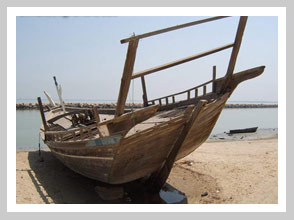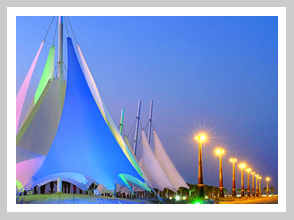Eastern Province
Eastern Province is a strategic gateway to international trade and tourism. It brings the Kingdom of Saudi Arabia large markets. Its coastline, over the centuries, has served as vital link in East-West trade. In the early to mid 20th century, the province emerged as the virtual commercial capital of the Arabian Peninsula. By the second half of the 20th century, the province obtained enormous economical strength – thanks to substantial oil discoveries in the early 20th century. This led to significant investments in infrastructures which further enhanced economic growth. Apart from oil and gas industries, the province’s strength revolves around growing agricultural sector, electricity industry, water desalination plants, petrochemical complex, and vast network of downstream industries. Now, the province (with its modern roads, ports, airports, communications and financial services) truly serves as an arterial route between neighboring countries, India, Far East, Europe and America. Eastern Province, with more than 36% of Saudi Arabia’s total area, is the largest province in the Kingdom. It extends from the borders of Kuwait and Iraq in the north to the desert of Al-Rub Al-Khali (The Empty Quarter: the largest sand desert occupying Southern part of the Kingdom) where the country borders Yemen and Oman. It also has land and/or sea borders with Bahrain, Qatar, United Arab Emirates (UAE) and Oman in the east. In this respect, King Fahd Bridge is an engineering wonder which connects Bahrain to the Eastern Province. The province is also well linked to Kingdom’s other provinces and to strategic ports of the Red Sea (e.g., Jeddah) in the west. Such links have become possible through well developed infrastructures, such as modern highways, railways and pipelines.

The most unique feature of Eastern Province is the enormous natural resources, particularly oil and gas. The region is located on the top of the largest ocean of underground oil reserves in the world. It has more than 20% of world’s total 1.3 trillion barrels of proven oil reserves. Saudi Arabia has more than 100 oil and gas fields, out of which more than 50% of its oil reserves are contained in eight fields in Eastern Province. The giant 3,262 Km2 Ghawar (the largest oil field in the world) is estimated to hold 70 billion barrels of crude oil. Further, Saffaniyah, including Khafji and Hout (the world’s largest offshore oilfield) is estimated to have 25-35 billion barrels crude oil. Furthermore, it should be noted that this uniqueness is not just limited to quantity of oil reserves. Around two-third of Saudi oil reserves are considered “light” or “extra light” grades oil, which are high quality crude oil that can produce more premium products (e.g., gasoline) with relatively lower costs, as compared to what would cost to derive similar products from “medium” or “heavy” grades oil.

Apart from being unique in terms of oil industry as its main engine for economic development, Eastern Province is considered to be the most industrialized part of the Kingdom too. More than 86% of Saudi basic industries are located in this province. Industrial areas in Dammam and Jubail demonstrate significant achievements and unique development in the entire region. In addition, the province is exceptional due to its magnificent sandy coastlines with beautiful public parks, green areas along its coastal lines. Eastern Arabia is sometimes called Al-Ahsa (or Al-Hasa) after the largest oasis and one of the most fertile areas of the country.
The administrative and territorial division of Eastern Province includes 10 districts.The largest towns include Dammam, Al-Hasa, Al-Jubail, Ras Tanura, Dhahran, Al-Khobar and Al-Qatif.
